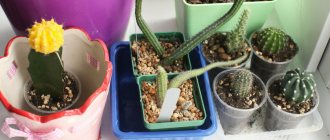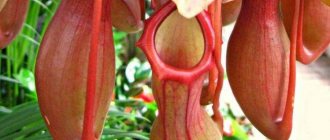Sansevieria or Sansevieria is one of the champions in oxygen production among houseplants; at the same time, this plant absorbs substances harmful to health from the air. For its striped, hard and long leaves, Sansevieria has received the popular name “pike tail”. Sansevieria is unpretentious in care and is successfully grown by novice gardeners. This plant is very decorative, looks impressive indoors, and is often grown at home, in offices and winter gardens.
Lighting
In its homeland, Sansevieria grows in conditions of strong solar activity. However, it does not necessarily need to be in the sun to grow and develop.
Mother-in-law's tongue feels great in diffused light and partial shade.
Sansevieria is very unpretentious, but variegated varieties require more light and may even lose their color if there is not enough light.
Direct sunlight does not harm sansevieria at all , so if it is exposed to the sun for several hours a day, no sunburn will appear on the leathery leaves.
Watering
Sansevieria stores a large amount of moisture in the rhizome, and hard leaves evaporate it very poorly. Therefore, this plant does not need abundant watering and is even harmful. It is adapted to water shortages and dry soil.
Water the sansevieria so that the lump of earth dries out at least 2/3 . In summer, the flower needs to be watered well once every 10 days, and then the substrate in which it grows should be dried.
In winter, watering is reduced, watered once every 2-3 weeks, depending on the room temperature. Sansevieria is not picky about the temperature and composition of water. However, you should not water the plant with cold water.
A flower for happiness and a leaf for mental anxiety
Many people don’t know, but mother-in-law’s tongue is blooming.
The belief is that flowering foretells a dream coming true. It is rare to see thin green stems and white flowers on a magical plant. If you see them, expect good luck and happiness in your home. According to other beliefs, flowering in winter brings bad luck, quarrels, illnesses of relatives and loved ones. Flowering in warm seasons is a harbinger of minor troubles and failures. The plant is very mysterious, but no less stunning for that. Other beliefs attribute medicinal powers to it. If you suffer from insomnia and anxiety, a pike tail will give peace to any heart. To do this, take scissors, cut off a leaf of the plant, wash and dry. When giving it to a person, do not forget to remind them to keep it under the pillow. This flower has powerful energy. He doesn't like negativity and is always ready to take the blow. If you see broken and damaged leaf tips, be careful and take action. Perhaps someone is already in a critical, depressed state and requires treatment. Timely measures taken will save a person’s health, and possibly life. The plant is not able to cope only with very strong negative currents and thoughts. A pike tail can become for you a kind of gauge of the intensity of passions in the room. Tall and dense leaves will indicate to you the negative attitude of others towards each other, black envy. Negativity, sidelong glances, resentment and anger feed the plant. Thanks to this fertilizer, it can grow about one and a half meters long. Mother-in-law's tongue is not ready for compromise; magical power is the main thing that nature has endowed it with.
The soil
In nature, Sansevieria grows on depleted rocky soils of semi-deserts. But in apartment conditions it is not at all necessary to plant it in an earthen mixture for succulents.
The plant is not susceptible to rotting, so mother-in-law’s tongue grows best in a universal soil mixture with the addition of raising agents : brick chips, perlite, fine gravel.
You can mix the substrate for planting sansevieria yourself. The most optimal composition: 4 parts turf soil, 1 part sand, 2 parts leaf soil, 1 part brick chips.
Soil preparation
Sansevierias are replanted once a year, if the plant is still young. If the sansevieria is more than two years old, then the transplant is carried out once every three years. It is best to replant in the spring. The indoor plant has a very extensive root system, so the pot must be selected taking into account the fact that the roots will grow and may begin to destroy the container. In order to prepare the soil for transplanting sansevieria, you need to take four parts of leaf soil, one part of turf soil and one part of sand. It is also possible to add peat or humus. It is necessary to ensure very good drainage for the plant.
Humidity
Existing in steppe and semi-desert climates, the plant has adapted to very dry air. Therefore, it is not necessary to maintain a certain humidity in the room where Sansevieria grows. In conditions of high humidity, the plant also does well, although the risk of root rot increases.
Sansevieria is not sprayed . It does not require high air humidity, and water getting inside the outlet can lead to its rotting. In order for the flower to have a beautiful appearance and not be dusty, it is enough to periodically wipe the leaves with a damp cloth.
Diseases
Sansevieria is a plant that is very resistant to various infectious and fungal diseases.
Sometimes, when the soil is heavily waterlogged, root rot develops, and when water gets into the rosette, the leaves rot.
To preserve the plant, it is enough to reduce watering, dry the soil, and remove the affected rosettes.
Pests very rarely settle on sansevieria . Sometimes you can find mealybugs or scale insects, but the pests do not breed here in large numbers.
Therefore, they are often limited to only mechanical removal of harmful insects. If it is not possible to destroy the pests, you need to spray the plant with insecticidal preparations.
Problems
When growing sansevieria, even novice gardeners rarely have problems. But sometimes, due to significant errors in care, this flower can even die. It is necessary to regularly inspect it and analyze changes in its appearance.
Most often, the plant suffers from excessive watering. In this case, the leaves turn yellow and die, and they become soft. If you do not reduce watering, the root system may begin to rot.
With a lack of moisture, if sansevieria is not watered for months, the leaves become limp and wrinkled.
With prolonged exposure to low temperatures, the growth of the flower slows down greatly, then its leaves wither and die. In this case, if the temperature in the room is not increased, the plant may die.
When there is insufficient lighting, thin, weak leaves grow, and Sansevieria stretches out . Variegated varieties may lose light stripes or borders in the dark. If left in a dark place for a long time, brown spots may appear on the leaves, especially if over-watered.
Reproduction
In apartment conditions, Sansevieria propagates very easily by vegetative means. To propagate Sansevieria or mother-in-law's tongue, separate rosettes, parts of rhizomes and cut leaves are used.
The rosette, separated from the plant, and rhizome fragments are planted directly in separate permanent pots. This procedure is carried out in spring or summer during the growing season.
When dividing the rhizome, it is important that the planted part has at least one growth point. Then, with moderate watering of the shoots, they soon begin to grow and send out new shoots.
Sansevieria can be propagated from cut leaves . They are placed in water or immediately planted in the ground to a depth of 2-3 cm. To avoid rotting of the leaves, they should be watered moderately. After 1.5-2 months they take root and then form new shoots.
Now you know how to propagate mother-in-law's tongue at home.
Transfer
Young plants need to be replanted once every 2 years. Adult flowers are rarely replanted - once every 4-5 years, when the side shoots become cramped in the old pot. Sansevieria or mother-in-law's tongue is transplanted in spring or early summer.
The pot for the plant should be wide and shallow, since it grows wide and does not have long roots. First, the flower is removed from the pot and excess rosettes and shoots on the sides are cut off. The trimmed parts are planted in separate containers, and the old plant is transplanted into the previous pot using the transfer method.
Before planting sansevieria, you need to pour a good drainage layer a few centimeters thick of expanded clay or shards onto the bottom of the pot. Then a layer of fresh soil is poured onto the bottom, the plant is placed in a pot and the rhizome is sprinkled with fresh soil.
The plant should not be planted too deeply, and after replanting it is useful not to water it for 2-3 days so that all damage to the roots is healed.
To bloom or not to bloom - the plant decides this question itself
"Cuckoo's Tail" may not bloom for years, and then suddenly please the owners - bloom in the summer with delicate whitish-yellow-green flowers and narrow petals, fragrant like the aroma of vanilla.
A bunch of inflorescences that look like small stars appear on the discarded peduncle. They secrete drops of nectar that attract insects in a certain environment.
The aroma from them can spread throughout the entire room, and can be “heard” even on the landing - it is so intoxicating. It blooms in the evening, blooms at night, and closes during the day. Pleases with its beauty for no more than a week.
The reason for the sudden flowering is not good care at all, but the fact that the instinct of procreation awakens in the “mommy”, like in any living organism.
When she begins to feel her death approaching, the force of nature forces her to bloom to leave behind seeds.
This happens at a time when the pet’s rhizome grows greatly and fills the volume of the flowerpot so that it becomes cramped, the nutrients dry up - at such a moment it decides to show all its beauty.
Even without knowledge or experience in the field of floriculture, every person will be able to decorate their home with one of the classes of an unassuming miracle of nature.
Collectors can get a wealth of information on the Internet about the uniqueness of this beauty, from compact types to one and a half meter types.
Unfortunately, many rare types of exotic flowers are not fully studied and not appreciated due to their inaccessibility to other countries.
Useful tips
For amateur gardeners who grow sansevieria, you need to know a few useful tips, as well as the medicinal properties of the plant:
- "Mother-in-law's tongue" grows very quickly, but when it reaches its maximum height, its growth stops;
- The plant contains useful biologically active substances, for example, saponins. After undergoing the necessary processing, they can be used in medicines;
- Their sansevieria tincture can be used as an enema to eliminate intestinal problems;
- Sansevieria extract is used in the manufacture of choleretic, anti-inflammatory and laxative drugs. The juice of the leaves of the plant can be instilled into the ears for otitis, the skin of the leaves has wound-healing properties, and a decoction from the plant helps with infections of the genitourinary system.
Mother-in-law's tongue flower: signs
The indoor flower mother-in-law's tongue, according to popular belief, is a symbol of well-being. This plant is incompatible with quarrels, disagreements and scandals. All negativity is caught and intercepted by pointed leaves. Signs with the mother-in-law's tongue flower are associated only with positive aspects. It is believed that its bloom is a sign of new beginnings. The buds will wither to warn household members about imminent problems and troubles.
Before believing in signs, you should pay attention to the time of year and the characteristics of care. Care, timely feeding and adherence to watering rules will allow you to correctly evaluate the “hints” of the mother-in-law’s tongue flower.
Mother-in-law's tongue is a plant that has a beneficial effect on the spiritual atmosphere in the house and has excellent healing properties. Its leaves have antiseptic qualities and are widely used in folk medicine to treat wounds, abrasions and burns.
Toxicity of the plant and precautions for care and placement
Although Sansevieria is a beautiful plant and can be used for medicinal purposes, ingestion of its juice can cause serious poisoning.
It's all about saponins - useful substances that, after special processing, are used in medicines. However, in large doses they turn into poison.
Signs of Sansevieria poisoning are : pain and burning in the throat, excessive salivation, vomiting and diarrhea.
Cats and dogs that decide to chew the leaves of Pike Tail will experience vomiting, intestinal upset, and may develop dermatitis.
However, it is important to consider that all these symptoms can only appear if the plant juice enters the body. When applied to the skin, the juice has wound-healing properties.
Due to the fact that Sansevieria is a poisonous plant, certain precautions should be taken when placing and caring for it:
- All manipulations with the flower, for example, replanting or pruning, must be carried out with gloves and make sure that the juice does not get into the eyes;
- All trimmed parts of the plant must be immediately destroyed or thrown away;
- Sansevieria should not be placed in rooms where small children sleep or play;
- If there are cats or dogs in the house, it is better to place the plant out of their reach;
- At the first signs of poisoning with sansevieria juice, you need to induce vomiting, then drink activated charcoal and seek help from a doctor.
Signs associated with “mother-in-law’s tongue”
“Mother-in-law’s tongue” also has many popular names: “pike tail”, “Indian sword”, “snake skin”, “devil’s tongue” and this influenced the emergence of various signs and superstitions, most often unfounded, associated with this plant:
- a plant of gossip - some believe that “mother-in-law’s tongue” brings frequent quarrels and family destruction into the house. This is an absolute lie - Sansevieria is an excellent plant for strengthening the family - quarrels and showdowns disappear, love and mutual understanding return
- energy - the plant absorbs negativity - rudeness, bad mood, anger and sets up positive communication, while emitting the energy of creativity and peace
- getting rid of ill-wishers - the plant is able to stop gossip and drive away ill-wishers
- flowering of a plant - it is believed that if “mother-in-law’s tongue” blooms in winter, this is a sign of a major scandal associated with excessive care. If flowering occurs at any other time of the year except winter, this is a good sign that speaks of good luck in new endeavors.
Description of the plant and species
Sansevieria is valued by gardeners for its rapid growth and original color of succulent leaves, amazing vitality and ease of care.
"Pike tail" is a member of the Agave family or, according to other sources, Asparagus. This perennial evergreen plant, which does not have a stem, grows naturally in savannas, semi-deserts and deserts of Africa and Asia.
The plant is a succulent that stores water in its tissues . It has an underground creeping rhizome with powerful rhizomes. Erect, fleshy leaves grow upward from a powerful root. They are very dense, lanceolate in shape, often covered with a waxy coating and pointed at the ends.
There are varieties of Sansevieria in which the leaves reach a height of more than a meter. Other species have small rosettes that grow wider than tall. Depending on the variety and type, the leaves can be painted in different shades of green or brown, and there may be horizontal or vertical stripes on their surface, or a bright edging.
“Mother-in-law’s tongue” blooms in early spring - the rosette produces a long peduncle, on which small white flowers are collected in a spike-shaped inflorescence, emitting a pleasant vanilla aroma.
Sansevieria blooms for 2 weeks.
The most common types for indoor floriculture are:
- Sansevieria three-lane - has long sword-shaped leaves reaching 1 meter in length. They have a bright green color with darker transverse stripes. A yellow-white border may be present.
- Sansevieria Hanni is a low-growing species, up to 30 cm high. Dark green leaves with various light stripes or inclusions form a rosette. It has several subspecies with different leaf colors.
- Sansevieria is large - it has wide fleshy leaves, 30-60 cm high, up to 15 cm wide. Their color is light green with dark transverse stripes and a reddish border.
- Sansevieria cylindrical - has dark green cylindrical leaves, 1.5-2 cm in diameter, with silvery transverse stripes. There is a deep groove along the leaf.
basic information
Much has changed since the unprecedented popularity of this flower; a huge number of more spectacular and exotic “pets” have appeared, displacing Sansevieria on its pedestal. However, breeders did not leave “mother-in-law’s tongue” without attention and, based on it, developed many decorative, hybrid forms that attract interested glances.
This evergreen stemless plant belongs to the Asparagus family and the flower genus consists of almost six dozen species. You can meet it in its natural environment in Asian and African deserts, semi-deserts and savannas. As a house plant, flower growers grow it in different parts of the world and everywhere Sansevieria is given another, poetic name, calling it “pike tail”, “leopard lily”, “cuckoo tail”, “Indian sword”, “snake skin” and even “African hemp" and "the tongue of the devil." In addition, there are several Latin variants, in addition to sansevieria these are sansevieria and sansevieria.











